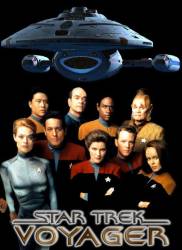Continuity mistake: When Tom explains to Alice why he can't leave the Voyager, he has a three-day beard. Later in the ship, when Alice convinces him to turn on the neurological interface, he is cleanly shaved. But in the next scene he has his beard back again.
Continuity mistake: When future Kes is talking to Neelix in the kitchen, when he says he's already reserved the holodeck, he's holding the smaller container. In the next shot, the smaller container is on the counter and he's holding the bigger pot.
Continuity mistake: When Harry uses the scanning tool, the lights alternate between flashing from top down to bottom up and back between angles.






Suggested correction: It's also possible that it's simply required of Ocampan women to give birth the first time they go through it, and can then experience it again.
Greg Dwyer
Nothing in the dialogue suggest Ocampa's can have additional children. While we can speculate about fictitious species, it's still a plot hole due to writing. Kes states she's going through the "elogium" which is a time of change where her body prepares for fertilization. She then explicit states the "elogium" only occurs once. While the doctor compares it to puberty, the elogium is both sexual maturity and "heat", that is, the time a female is ready for fertilization.
Bishop73
But it doesn't ever state the normalcy of birthing for Ocompans. Perhaps sextuplets is the norm?
Kes frequently used the word "child." If it was normal to give birth to more than one, she would know this and should say "children."
Bishop73
Do not forget that this is all done through the universal translator. For all you know the Ocompan word for child and children is the same so the translator cannot tell the difference.